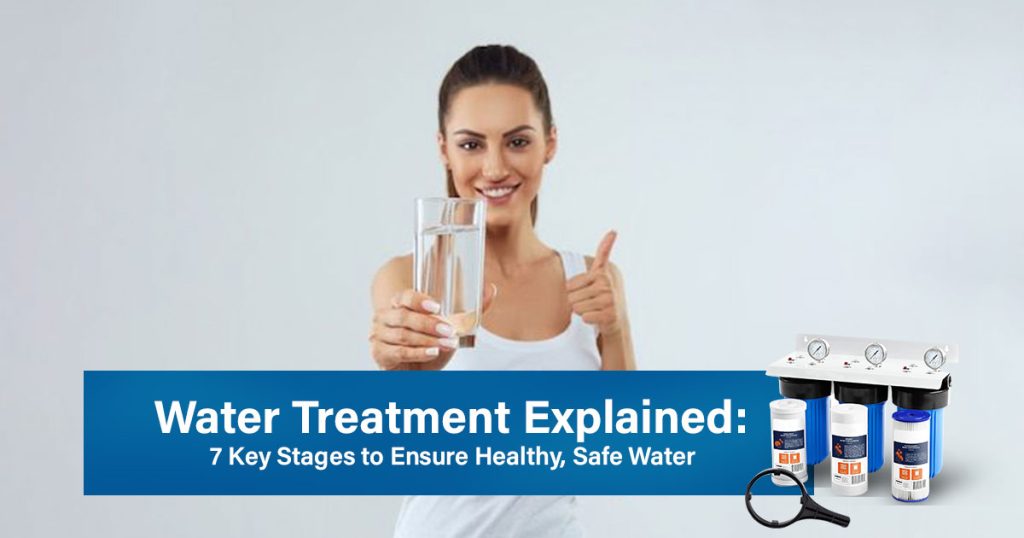Water treatment is the process that turns raw water into safe, clean water for homes and businesses. It eliminates harmful bacteria, toxins, and grime that could endanger health, ruin equipment, or reduce the lifespan of plumbing. Knowing this process helps us to make better decisions when purchasing a filter, as well as understand how water is purified. Knowing these stages enables families to choose the most suitable system for their water quality, addressing specific issues.
Clean water is not just a matter of taste. It protects health, encourages adult activity and energy, and promotes children’s development. Without treatment, water may carry hidden risks that slowly harm the body over time. This is why every stage of treatment plays a role in building trust in the water you drink. By the time it reaches your tap, water has gone through several steps that work together to make it safe.
For buyers, the knowledge of these stages becomes a guide. Families looking at residential systems or businesses considering commercial filters can see how each product handles different concerns, such as sediment, chlorine, or heavy metals. The right choice gives both peace of mind and long-term savings. With that in mind, let us look at the seven key stages of water treatment and why they matter when choosing a filter.
The water treatment process includes the following stages:
- Pre-screening
- Aeration
- Flocculation
- Sedimentation
- Fluoridation
- pH adjustment
- Filtration
- Pre-screening
Pre-screening is the first line of defense in water treatment. At this stage, larger particles like sand, rust, and dirt are removed before water moves to deeper cleaning. For buyers, this matters because a simple pre-sediment filter can save money by protecting the more advanced stages that follow. If large debris is not removed, it can clog carbon filters or wear out reverse osmosis membranes faster, leading to higher replacement costs.
In homes, pre-screening filters are often the first cartridge in a whole-house system. Brands such as iSpring and 3M provide pre-sediment filters that block rough particles right at the entry point. This keeps water flowing smoothly and protects appliances such as washing machines, dishwashers, and hot water systems.
The real value for buyers lies in the system-wide protection. Families who invest in pre-screening enjoy fewer plumbing issues, longer-lasting filters, and cleaner water at every tap. By starting strong with pre-screening, the rest of the treatment process becomes more effective, making this a smart first step for any homeowner planning a reliable water treatment setup.
- Aeration
Aeration is the process of mixing air with water to release unwanted gases and improve freshness. This step clears out odors like sulfur and reduces gases such as carbon dioxide. It also helps remove iron and manganese, which can stain sinks, clothes, and fixtures.
For buyers, aeration is important because it improves both the taste and appearance of water before it even reaches advanced filters. Families notice the difference when water smells fresh and looks clear. It also means less staining on laundry and plumbing fixtures, which saves money on cleaning and repairs.
In larger municipal or commercial systems, aeration has another advantage: it reduces the need for extra chemicals, since some contaminants get removed naturally by air. For households, choosing a system that includes aeration or pairs well with an aeration unit is a smart move. It gives cleaner water, lowers maintenance on appliances, and makes the later stages of treatment more effective.
3. Flocculation
Flocculation is the process in which a special solution, often called a coagulant, is added to water so that tiny particles stick together. These particles form larger clumps known as flocs, which are easier to remove in the next stage. It tackles impurities that are too fine to settle on their own, such as clay, dirt, and organic matter.
For buyers, the benefit of flocculation is clear water that looks and tastes better. It also protects the filters that follow, since fewer fine particles pass through. That means systems like carbon filters or reverse osmosis membranes last longer and work more efficiently, lowering long-term replacement costs.
In both city treatment plants and home-based setups, flocculation plays a key role in reducing risks from hidden contaminants. Families that choose systems designed with effective flocculation enjoy safer drinking water with fewer interruptions, better taste, and stronger protection. For anyone comparing treatment systems, understanding flocculation helps explain why some filters perform better over time.
- Sedimentation
The stage of sedimentation is when water is held still so that large masses of mud, sand, and other particles sink to the bottom. It is among the easiest but most efficient ways to eliminate bigger impurities before water runs to more delicate filtration. Letting gravity take care of this phase guarantees easier operation and lessens the load on the next filters, therefore enhancing the system.
For buyers, sedimentation matters because it directly protects plumbing, appliances, and household fixtures. Cleaner water reaching taps means fewer stains on sinks, reduced buildup in pipes, and longer life for machines like washing machines or dishwashers. It also means that filters such as carbon or reverse osmosis membranes will not clog as quickly, helping families save on replacement costs.
In both municipal plants and smaller home-based systems, sedimentation gives water a head start in the purification process. Families who invest in systems with effective sediment handling see real improvements in water clarity, system performance, and long-term maintenance savings.
- Fluoridation
Fluoridation is the stage where a controlled amount of fluoride is added to water to protect dental health. Balanced levels of fluoride lower the risk of tooth decay, especially in children, while keeping water safe to drink. In some systems, this stage also works to remove excess fluoride or arsenic when those levels are naturally too high in the water supply.
For purchasers’ concerns about fluoridation raise trust and balance issues. Water helps families maintain long-term health by strengthening teeth, and not only cools them down. Advanced systems also make sure that too much fluoride or arsenic is kept within acceptable levels, so the water stays safe.
When done properly, fluoridation improves the overall quality of drinking water without affecting taste or smell. For households choosing a water treatment system, knowing whether fluoride levels in the local supply are high or low is an important step. Matching the right system to those needs ensures both safety and lasting value.
- pH Adjustment
pH adjustment is the stage where the acidity or alkalinity of water is balanced to safe levels. Water that is too acidic can corrode pipes and appliances, while water that is too alkaline can leave scale and an unpleasant taste. By stabilizing pH, treatment systems ensure that water is safe for families to drink and gentle on home infrastructure.
Buyers, in particular, need this phase as it offers two degrees of security. First, it protects health by guaranteeing the water is safe to drink and by avoiding irritation. Second, it protects investments in plumbing and household equipment by reducing corrosion, scaling, and costly repairs. Families who use systems with effective pH balancing enjoy longer-lasting appliances, fewer plumbing issues, and consistently better-tasting water.
In both residential and commercial systems, pH adjustment adds measurable value. It transforms raw supply into water that not only meets safety standards but also works in harmony with homes and businesses. Buyers who want lasting reliability should look for systems that include strong pH management as part of their treatment process.
- Filtration
Filtration is the final stage where remaining dirt, chemicals, and microbes are removed from the water. This step uses carbon filters, reverse osmosis membranes, ceramic elements, or UV lights to trap harmful particles and neutralize germs. The result is water that is clean, safe, and ready for drinking or everyday use.
For buyers, filtration represents the assurance that every glass of water is free of hidden risks. It tackles chlorine, heavy metals, pesticides, and bacteria that earlier stages may not completely remove. Families benefit from healthier meals, clearer ice, safer cooking, and better protection for children and adults alike.
Filtration also brings convenience. Many modern systems use quick-change cartridges, smart indicators, and compact designs that fit under sinks or connect to main lines. This means buyers get both safety and simplicity without constant maintenance struggles. Choosing the right filtration system ensures daily access to safe water while adding long-term value by reducing bottled water use and protecting household appliances.
What Are the Best Water Filters Used in Water Treatment for Homes?
The best water filters used in water treatment for homes are systems that combine strong contaminant removal with ease of use, reliability, and good long-term value. Families sometimes search for choices that guard against hidden dangers like heavy metals, chlorine, or dangerous bacteria in addition to enhancing taste and smell. The iSpring RCC7AK, the Aquaboon 3-Stage Whole House Water Filter System, and the HQUA WF3-01 3-Stage Whole House Water Filtration System are among the most trusted picks.
1. Alkaline 6-Stage RO System
Price: $234.99
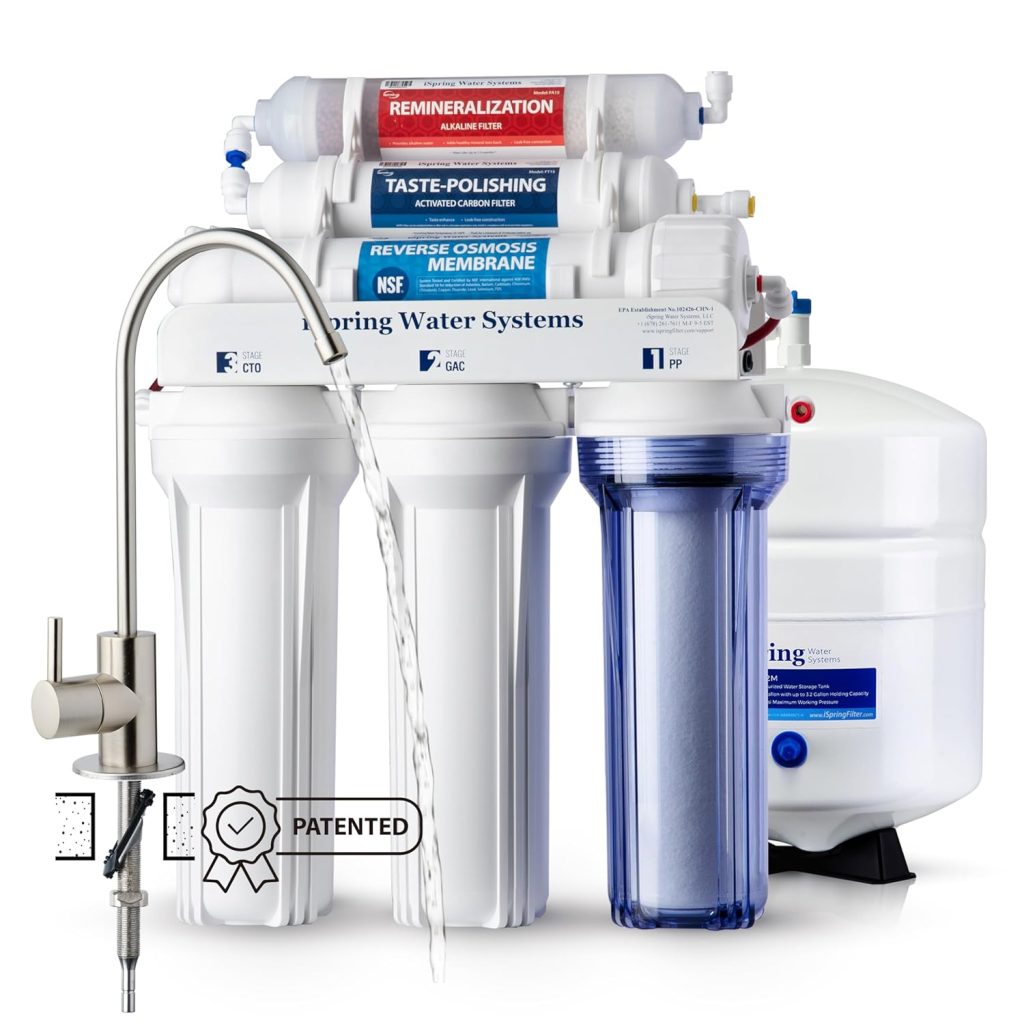
The iSpring RCC7AK is a 6-stage under-sink reverse osmosis system designed to deliver safe, fresh-tasting water for families. It produces up to 75 gallons per day and uses an alkaline remineralization filter to balance pH and restore minerals, preventing water from tasting flat. NSF certification ensures trusted performance and reliability.
Best Use Cases
Perfect for families seeking an affordable yet advanced under-sink solution that improves taste and adds beneficial minerals back into water.
Pros
- The 6-stage system removes a wide range of contaminants.
- Alkaline remineralization restores healthy minerals and improves taste.
- Easy installation with clear instructions and included parts.
- Compact design fits neatly under most sinks.
- Reliable customer service and warranty support from iSpring.
Cons
- Produces wastewater during filtration, which is common to RO systems.
- Filter replacements are required regularly, adding to upkeep.
2. Aquaboon 3-Stage Whole House Water Filter System
Price: $262.79
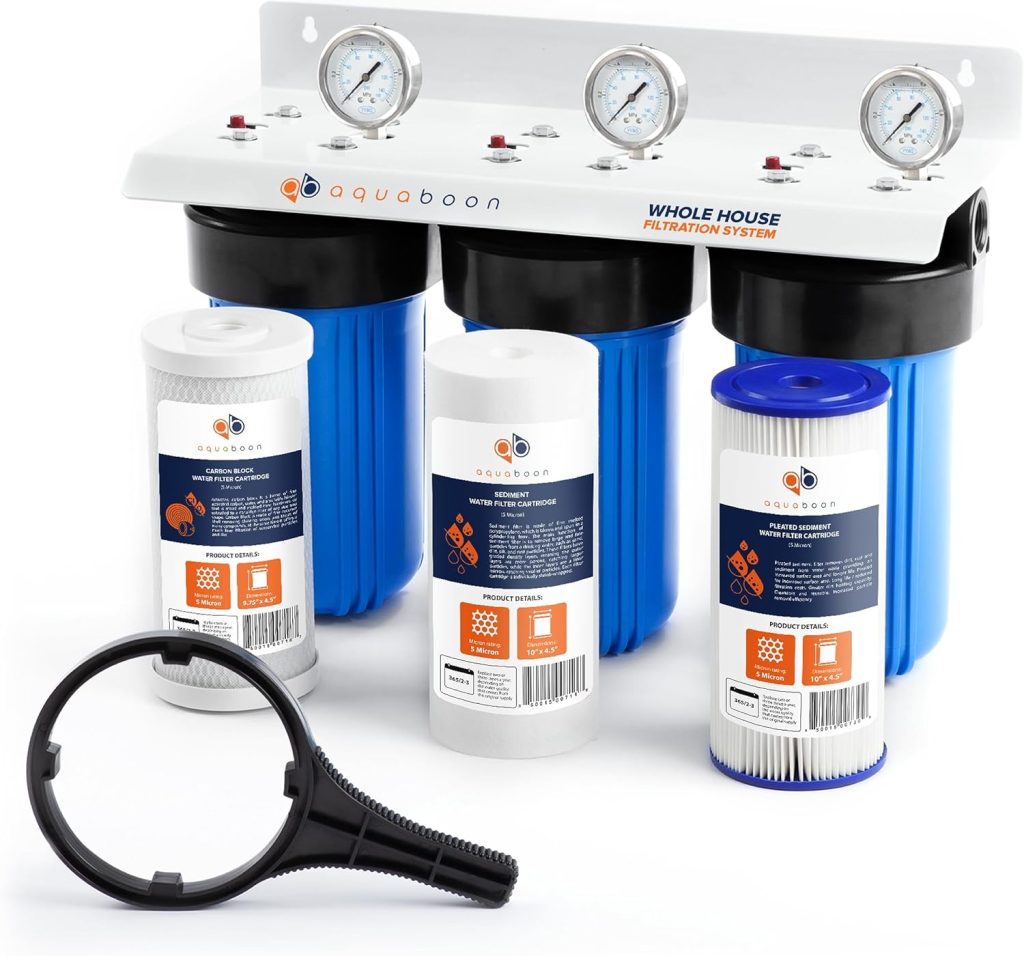
The Aquaboon 3-Stage Whole House Water Filter System protects the entire home by filtering water at the main supply line. It’s three layers: sediment, fine polypropylene, and activated carbon, which remove dirt, rust, chlorine, and odors to improve taste and clarity. NSF certification confirms dependable performance and safety.
Best Use Cases
Best for households that want whole-home water protection for drinking, cooking, bathing, and cleaning with straightforward maintenance.
Pros
- Multi-layer design improves water taste, smell, and clarity.
- NSF-certified for trusted safety.
- Protects appliances and plumbing from scale and sediment buildup.
- The package includes housings, cartridges, a mounting bracket, and a wrench.
Cons
- Filters need replacement every 6–12 months, depending on water quality.
- Does not remove heavy metals as effectively as premium systems.
3. HQUA WF3-01 3-Stage Whole House Water Filtration System
Price: $349.99
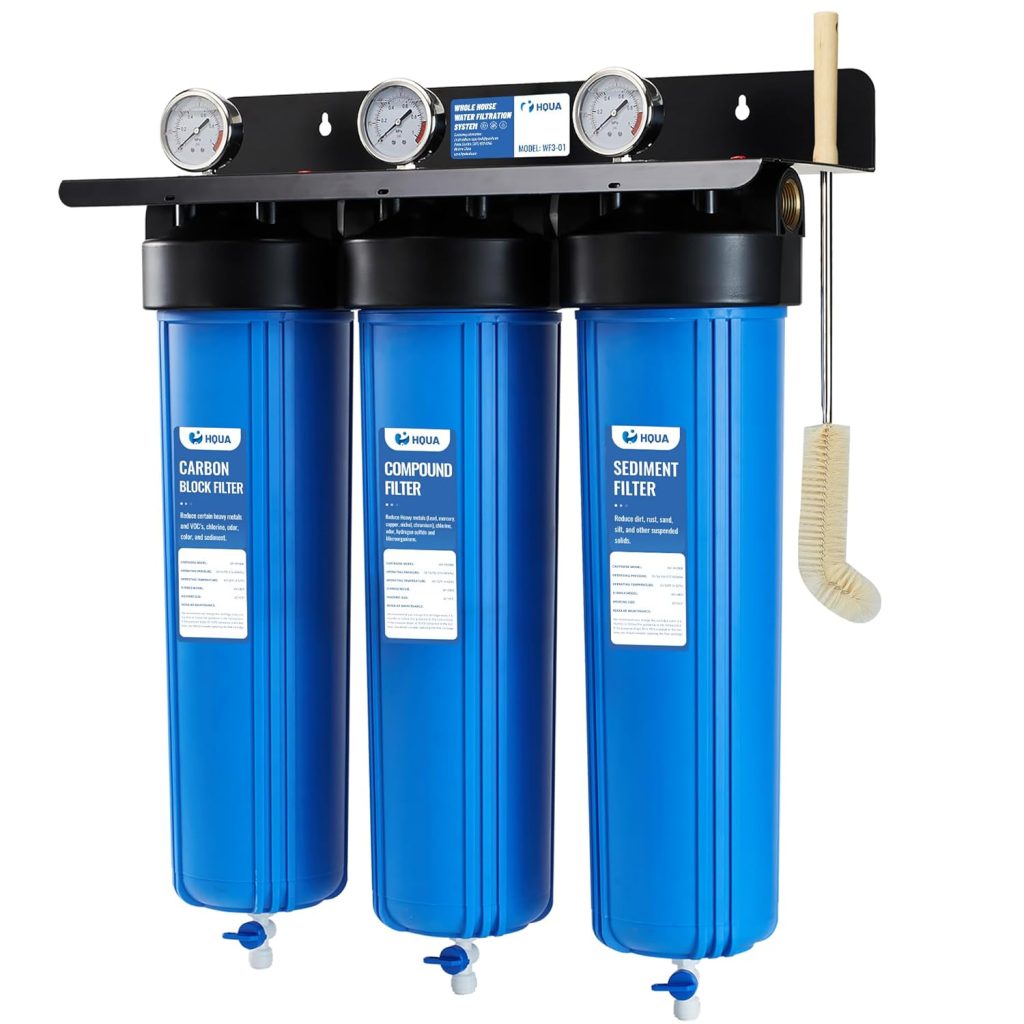
The HQUA WF3-01 is a 3-stage whole-home system designed to reduce heavy metals, sediment, chlorine, odors, and volatile organic compounds. With easy-maintenance valves, the system allows pressure relief and draining without full disassembly, making upkeep simple.
Best Use Cases
Best for families looking for effective heavy-metal reduction and reliable water quality throughout the home with easier maintenance.
Pros
- Targets heavy metals like lead, mercury, and copper.
- Improves taste and removes odors for fresher water.
- Easy-maintenance valves make servicing straightforward.
- Provides consistent, clean water for the entire home.
Cons
- Filter replacements are needed every 6–9 months.
- The larger unit requires installation space near the main supply line.
What Are Some Best Water Filters for Commercial Water Treatment?
Some of the best water filters for commercial water treatment are the 12” Quick Change Commercial Water Filter, 3M ICE120-S (5616003) Commercial Ice Maker Water Filtration System, and Ice-O-Matic IFQ2 Commercial Dual Water Filter. Commercial water treatment requires filters that can handle large water volumes, remove a wide range of contaminants, and operate reliably under heavy use. Businesses like hotels, factories, schools, and hospitals need strong filters that protect people and equipment.
Some common types of best filters for commercial water treatment include:
12” Quick Change Commercial Water Filter
Price: $152.98
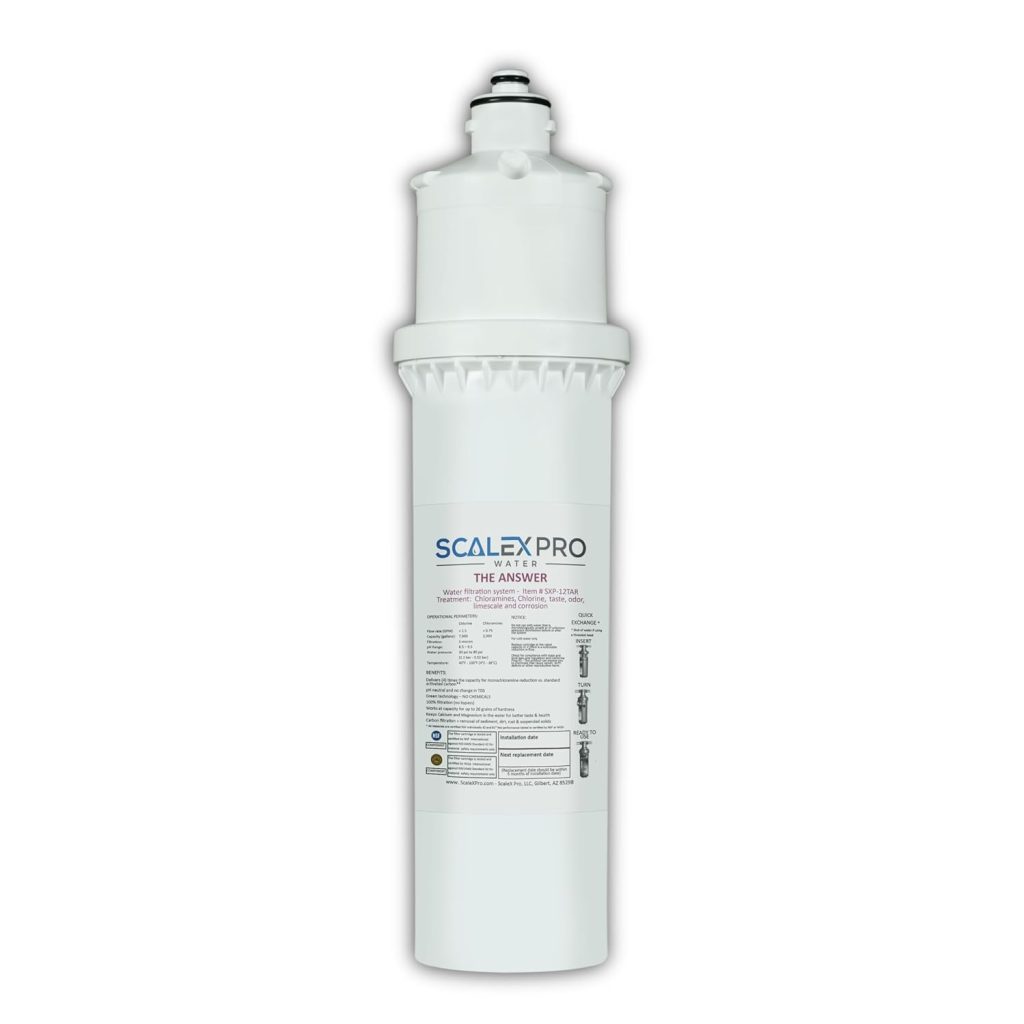
The 12” Quick Change Commercial Water Filter by ScaleX Pro is built for high-capacity use, handling up to 7,500 gallons before a cartridge change is needed. It uses a catalytic carbon block and Filtersorb SP3 material to reduce chlorine, chloramines, heavy metals, and unpleasant taste or odor. Its NAC technology also prevents limescale buildup in appliances like ice machines, coffee makers, and dishwashers.
Best Use Cases
This system is a strong fit for restaurants, hotels, cafeterias, and other commercial kitchens that want reliable water quality without complicated maintenance.
Pros
- High capacity (up to 7,500 gallons) before replacement.
- Tool-free cartridge change for quick maintenance.
- Protects equipment from limescale buildup.
Cons
- Does not remove every advanced contaminant.
- Cartridge replacement costs add up in high-demand settings.
3M ICE120-S (5616003) Commercial Ice Maker Water Filtration System
Price: $222
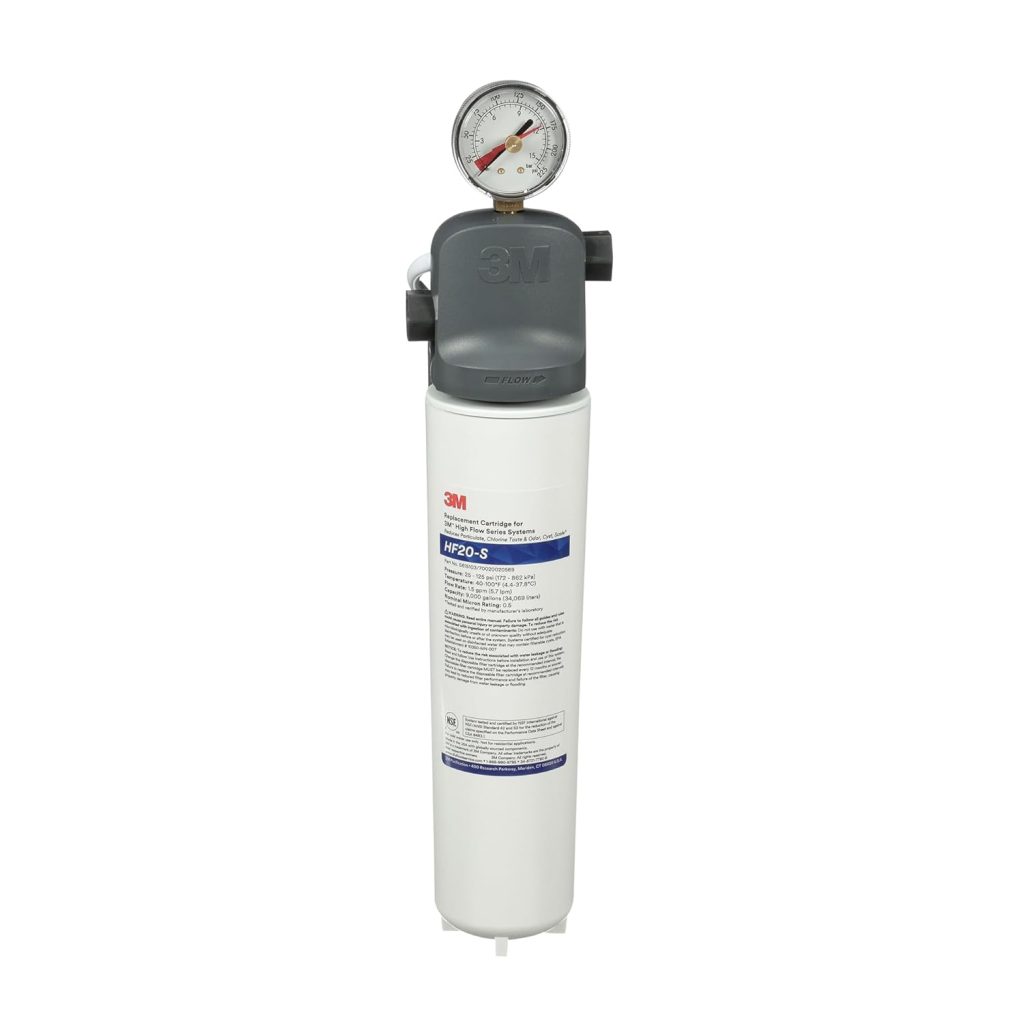
The 3M ICE120-S (Model 5616003) is made for heavy-duty ice production. It filters down to 0.5 microns, removing sediment, cysts, chlorine, and particles, while improving taste and odor. With a 9,000-gallon capacity and a flow rate of 1.5 gallons per minute, it’s built to support food service and commercial ice makers consistently. The Valve-in-Head design allows for simple installation and fast cartridge changes.
Best Use Cases
Perfect for commercial ice makers in restaurants, cafes, and bars where clear, safe ice is essential for customer satisfaction.
Pros
- Reduces sediment, chlorine, and cysts down to 0.5 microns.
- Protects ice machines from scale buildup.
- Easy installation with Valve-in-Head design.
Cons
- Flow rate may be limiting for extremely high-volume ice machines.
- Requires cartridge replacement about every 9,000 gallons.
Ice-O-Matic IFQ2 Commercial Dual Water Filter
Price: $733
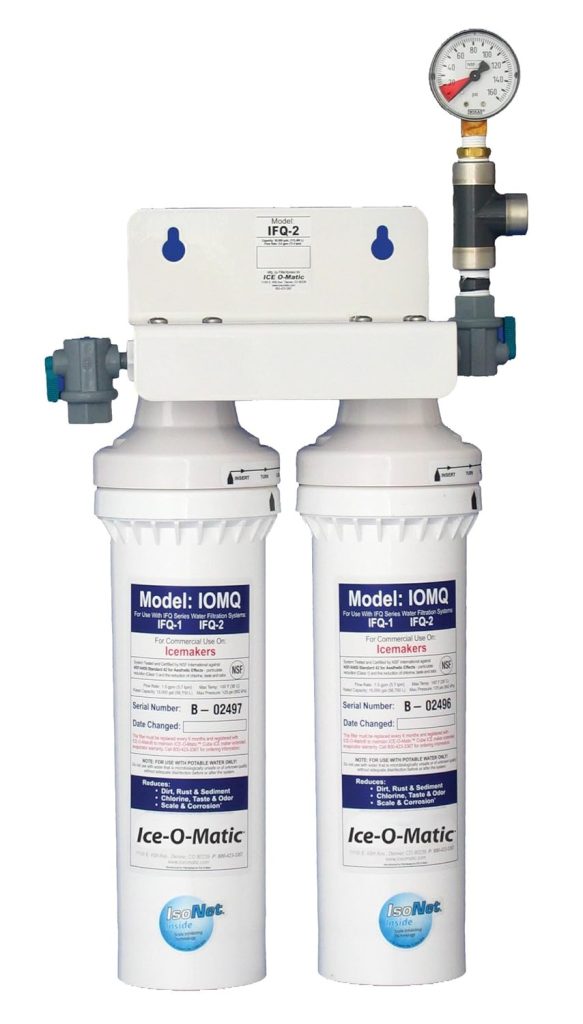
The Ice-O-Matic IFQ2 is a dual filter system designed for high-volume ice production, supporting machines that produce 1,050–1,400 pounds of ice daily. It removes particles down to 0.5 microns, chlorine taste, and odor while using IsoNet® scale inhibitor technology to reduce mineral buildup. Its dual manifold design allows one filter to be replaced while the other continues to operate, minimizing downtime.
Best Use Cases
Ideal for hotels, restaurants, and busy commercial kitchens that need consistent ice output and protection against costly downtime.
Pros
- The dual manifold allows continuous operation during filter changes.
- Removes chlorine, odors, and fine particles down to 0.5 microns.
- Prevents mineral buildup with IsoNet® scale inhibitor.
Cons
- Higher upfront cost compared to single-filter systems.
- Filter cartridges need replacing every 6 months.
How Water Treatment Ensures Safer Drinking With Smart Value?
Water treatment provides families with clean, safe water by removing harmful substances that can affect health over time. Bacteria, chemicals, and heavy metals in untreated water may quietly cause problems, but a properly chosen system ensures every glass, meal, and household use is protected.
At home, treated water gives peace of mind. It supports stronger growth in children, helps adults maintain better health, and reduces stress on organs like the liver and kidneys. Beyond health, treated water is convenient. Families can enjoy safe, fresh water directly from taps, reducing reliance on bottled water, cutting costs, and lowering environmental waste.
The smartest investment comes when a system is selected based on the water source and specific needs. Homes with well water often require sediment and mineral treatment, while municipal water may need chemical and chlorine removal. Matching the filter to the local water quality ensures lasting results, steady protection for appliances, and cleaner water for everyday use.
WaterFilterWay guides families in choosing systems that balance safety, convenience, and value. By understanding features such as filtration stages, maintenance, and certifications, households can confidently invest in solutions that deliver reliable, high-quality water and support long-term wellness.
FAQs
What Types of Water Filters Are Available for Home Use?
The types of water filters available for home use are sediment filters, carbon filters, reverse osmosis systems, ceramic filters, and ultraviolet filters. Each type targets different contaminants to keep water safe for daily use.
Why Is Pre-Screening Important in Water Treatment?
Pre-screening is important in water treatment because it removes large particles like sand, rust, and dirt before they reach later stages. This step protects filters, appliances, and plumbing from clogging and damage.
How Do Whole House Water Filters Improve Water Safety?
Whole-house water filters improve water safety by cleaning all the water entering a home. Every tap, shower, and appliance receives filtered water, which reduces contaminants, protects plumbing, and ensures safer use.
What Is Flocculation and How Does It Work?
Flocculation is the process of adding agents to water that bind small particles together into larger clumps. These clumps are easier to remove during later treatment, which makes the water cleaner and safer.
How Does Sedimentation Protect Households from Contaminants?
Sedimentation protects households from contaminants by letting heavy particles like dirt, sand, and rust settle at the bottom of a tank. This reduces the load on filters and keeps cleaner water flowing into the home.
Which Water Filter Brands Are Most Trusted for Safer Drinking Water?
The water filter brands most trusted for safer drinking water are iSpring, Aquaboon, HQUA, Aqua-Pure, 3M, and Ice-O-Matic. These brands hold certifications and provide reliable systems for both home and commercial use.
How Does pH Adjustment Ensure Safe Water for Consumption?
pH adjustment ensures safe water for consumption by balancing acidity and alkalinity. Balanced pH prevents pipe corrosion, protects appliances, and makes water safer and more pleasant to drink.
What Are the Key Benefits of Installing a Home Water Filtration System?
The key benefits of a home water filtration system are cleaner drinking water, lower risk of illness, better taste, protection for appliances, and long-term savings compared to bottled water.
Which Water Filter Is Best for Whole-House Protection?
The best water filter for whole-house protection is a point-of-entry system, such as a 3-stage whole-home filter. These systems treat all water before it enters the home, giving complete coverage.
How Can Commercial Water Treatment Systems Benefit Businesses?
Commercial water treatment systems benefit businesses by ensuring the availability of safe water for customers, protecting equipment from damage, lowering maintenance costs, and supporting compliance with health standards.

